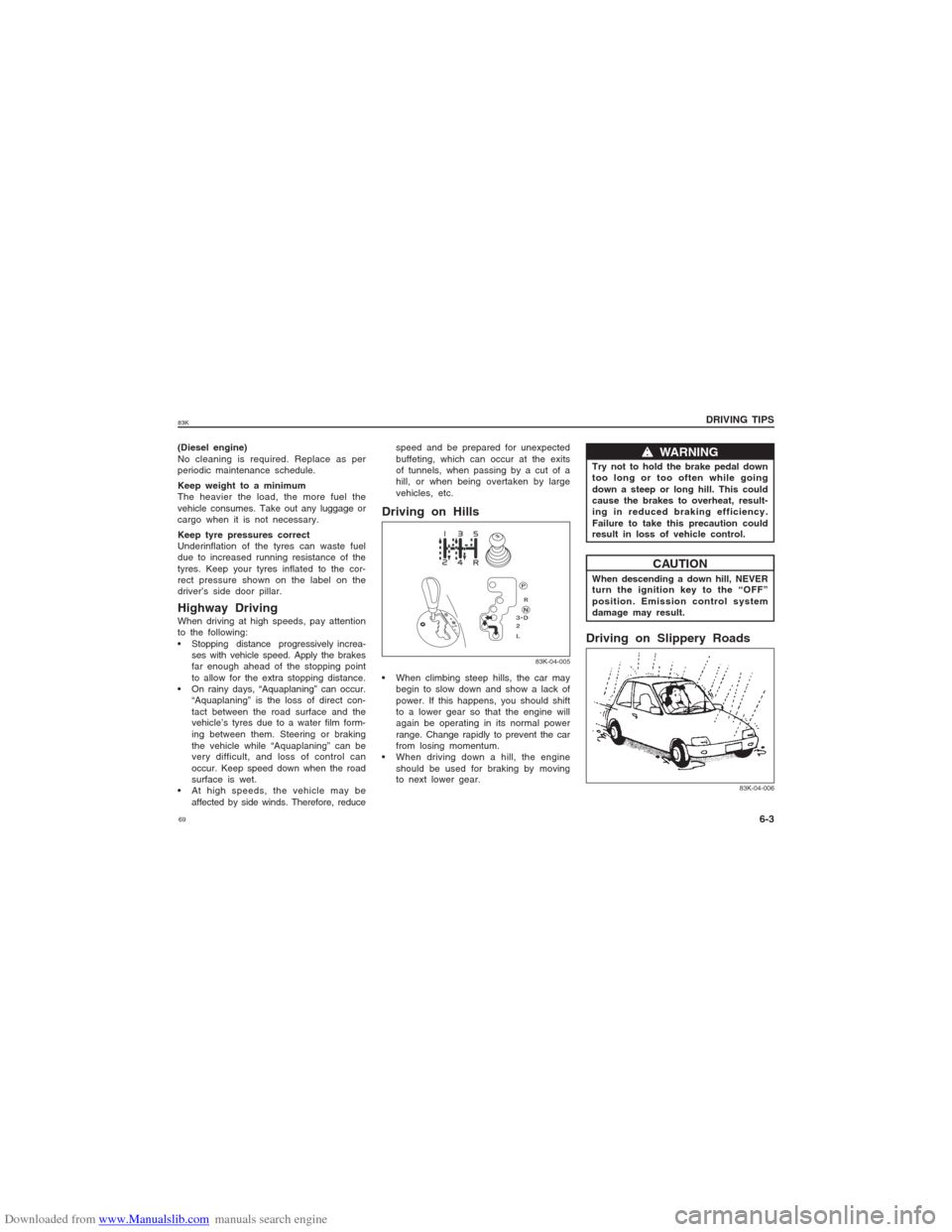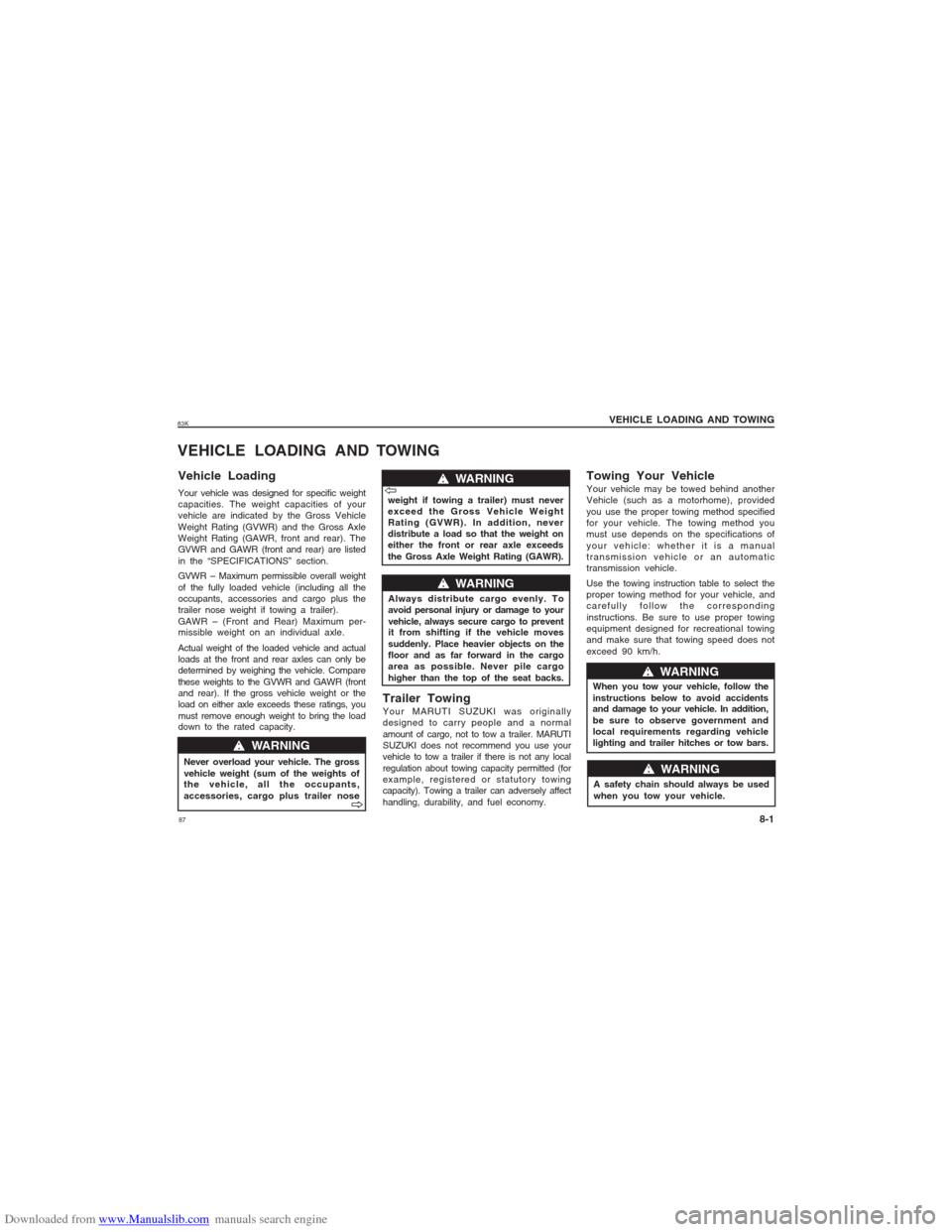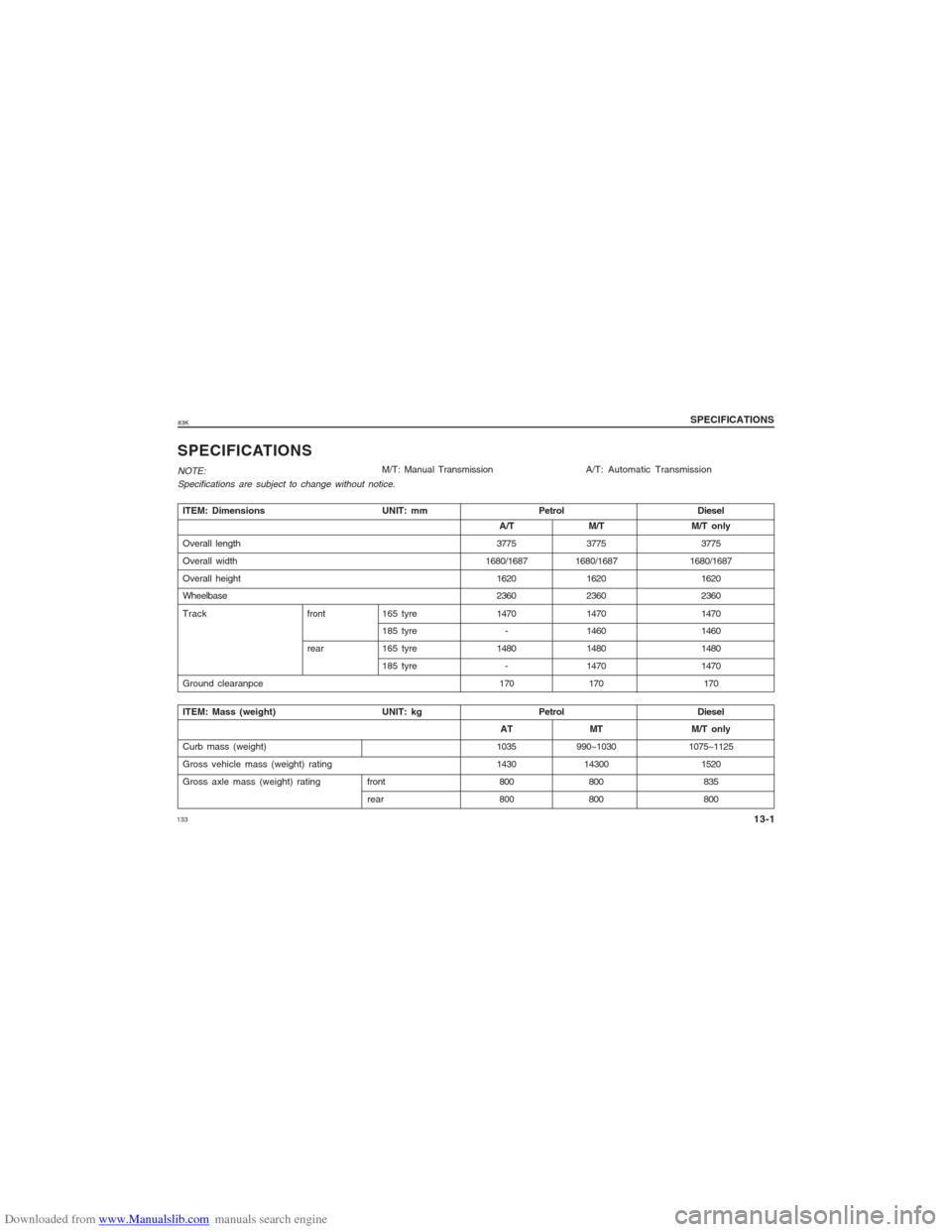weight SUZUKI MARUTI 2005 1.G Owners Manual
[x] Cancel search | Manufacturer: SUZUKI, Model Year: 2005, Model line: MARUTI, Model: SUZUKI MARUTI 2005 1.GPages: 136, PDF Size: 2.93 MB
Page 69 of 136

Downloaded from www.Manualslib.com manuals search engine 6983K
DRIVING TIPS
6-3
(Diesel engine)
No cleaning is required. Replace as per
periodic maintenance schedule.
Keep weight to a minimum
The heavier the load, the more fuel the
vehicle consumes. Take out any luggage or
cargo when it is not necessary.
Keep tyre pressures correct
Underinflation of the tyres can waste fuel
due to increased running resistance of the
tyres. Keep your tyres inflated to the cor-
rect pressure shown on the label on the
driver’s side door pillar.Highway DrivingWhen driving at high speeds, pay attention
to the following:
Stopping distance progressively increa-
ses with vehicle speed. Apply the brakes
far enough ahead of the stopping point
to allow for the extra stopping distance.
On rainy days, “Aquaplaning” can occur.
“Aquaplaning” is the loss of direct con-
tact between the road surface and the
vehicle’s tyres due to a water film form-
ing between them. Steering or braking
the vehicle while “Aquaplaning” can be
very difficult, and loss of control can
occur. Keep speed down when the road
surface is wet.
At high speeds, the vehicle may be
affected by side winds. Therefore, reducespeed and be prepared for unexpected
buffeting, which can occur at the exits
of tunnels, when passing by a cut of a
hill, or when being overtaken by large
vehicles, etc.
Driving on Hills
w ww w
w WARNING
Try not to hold the brake pedal down
too long or too often while going
down a steep or long hill. This could
cause the brakes to overheat, result-
ing in reduced braking efficiency.
Failure to take this precaution could
result in loss of vehicle control.
CAUTION
When descending a down hill, NEVER
turn the ignition key to the “OFF”
position. Emission control system
damage may result.Driving on Slippery Roads
83K-04-006
83K-04-005
When climbing steep hills, the car may
begin to slow down and show a lack of
power. If this happens, you should shift
to a lower gear so that the engine will
again be operating in its normal power
range. Change rapidly to prevent the car
from losing momentum.
When driving down a hill, the engine
should be used for braking by moving
to next lower gear.
Page 87 of 136

Downloaded from www.Manualslib.com manuals search engine 8783KVEHICLE LOADING AND TOWING
VEHICLE LOADING AND TOWING
Vehicle LoadingYour vehicle was designed for specific weight
capacities. The weight capacities of your
vehicle are indicated by the Gross Vehicle
Weight Rating (GVWR) and the Gross Axle
Weight Rating (GAWR, front and rear). The
GVWR and GAWR (front and rear) are listed
in the “SPECIFICATIONS” section.
GVWR – Maximum permissible overall weight
of the fully loaded vehicle (including all the
occupants, accessories and cargo plus the
trailer nose weight if towing a trailer).
GAWR – (Front and Rear) Maximum per-
missible weight on an individual axle.
Actual weight of the loaded vehicle and actual
loads at the front and rear axles can only be
determined by weighing the vehicle. Compare
these weights to the GVWR and GAWR (front
and rear). If the gross vehicle weight or the
load on either axle exceeds these ratings, you
must remove enough weight to bring the load
down to the rated capacity.
w ww w
w WARNING
Always distribute cargo evenly. To
avoid personal injury or damage to your
vehicle, always secure cargo to prevent
it from shifting if the vehicle moves
suddenly. Place heavier objects on the
floor and as far forward in the cargo
area as possible. Never pile cargo
higher than the top of the seat backs.
w ww w
w WARNING
Never overload your vehicle. The gross
vehicle weight (sum of the weights of
the vehicle, all the occupants,
accessories, cargo plus trailer nose
V VV V
V
w ww w
w WARNING
V VV V
Vweight if towing a trailer) must never
exceed the Gross Vehicle Weight
Rating (GVWR). In addition, never
distribute a load so that the weight on
either the front or rear axle exceeds
the Gross Axle Weight Rating (GAWR).Trailer TowingYour MARUTI SUZUKI was originally
designed to carry people and a normal
amount of cargo, not to tow a trailer. MARUTI
SUZUKI does not recommend you use your
vehicle to tow a trailer if there is not any local
regulation about towing capacity permitted (for
example, registered or statutory towing
capacity). Towing a trailer can adversely affect
handling, durability, and fuel economy.When you tow your vehicle, follow the
instructions below to avoid accidents
and damage to your vehicle. In addition,
be sure to observe government and
local requirements regarding vehicle
lighting and trailer hitches or tow bars.
w ww w
w WARNING
Towing Your VehicleYour vehicle may be towed behind another
Vehicle (such as a motorhome), provided
you use the proper towing method specified
for your vehicle. The towing method you
must use depends on the specifications of
your vehicle: whether it is a manual
transmission vehicle or an automatic
transmission vehicle.
Use the towing instruction table to select the
proper towing method for your vehicle, and
carefully follow the corresponding
instructions. Be sure to use proper towing
equipment designed for recreational towing
and make sure that towing speed does not
exceed 90 km/h.
w ww w
w WARNING
A safety chain should always be used
when you tow your vehicle.
8-1
Page 133 of 136

Downloaded from www.Manualslib.com manuals search engine 13383KSPECIFICATIONSNOTE:ITEM: Dimensions UNIT: mmPetrol Diesel
A/T M/T M/T only
Overall length3775 3775 3775
Overall width1680/1687 1680/1687 1680/1687
Overall height1620 1620 1620
Wheelbase2360 2360 2360
Track front165 tyre1470 1470 1470
185 tyre -1460 1460
rear 165 tyre1480 1480 1480
185 tyre -1470 1470
Ground clearanpce 170 170 170ITEM: Mass (weight) UNIT: kgPetrol Diesel
AT MT M/T only
Curb mass (weight)1035 990~1030 1075~1125
Gross vehicle mass (weight) rating1430 143001520
Gross axle mass (weight) rating front 800 800 835
rear 800 800 800
SPECIFICATIONS
13-1
M/T: Manual TransmissionA/T: Automatic Transmission
Specifications are subject to change without notice.